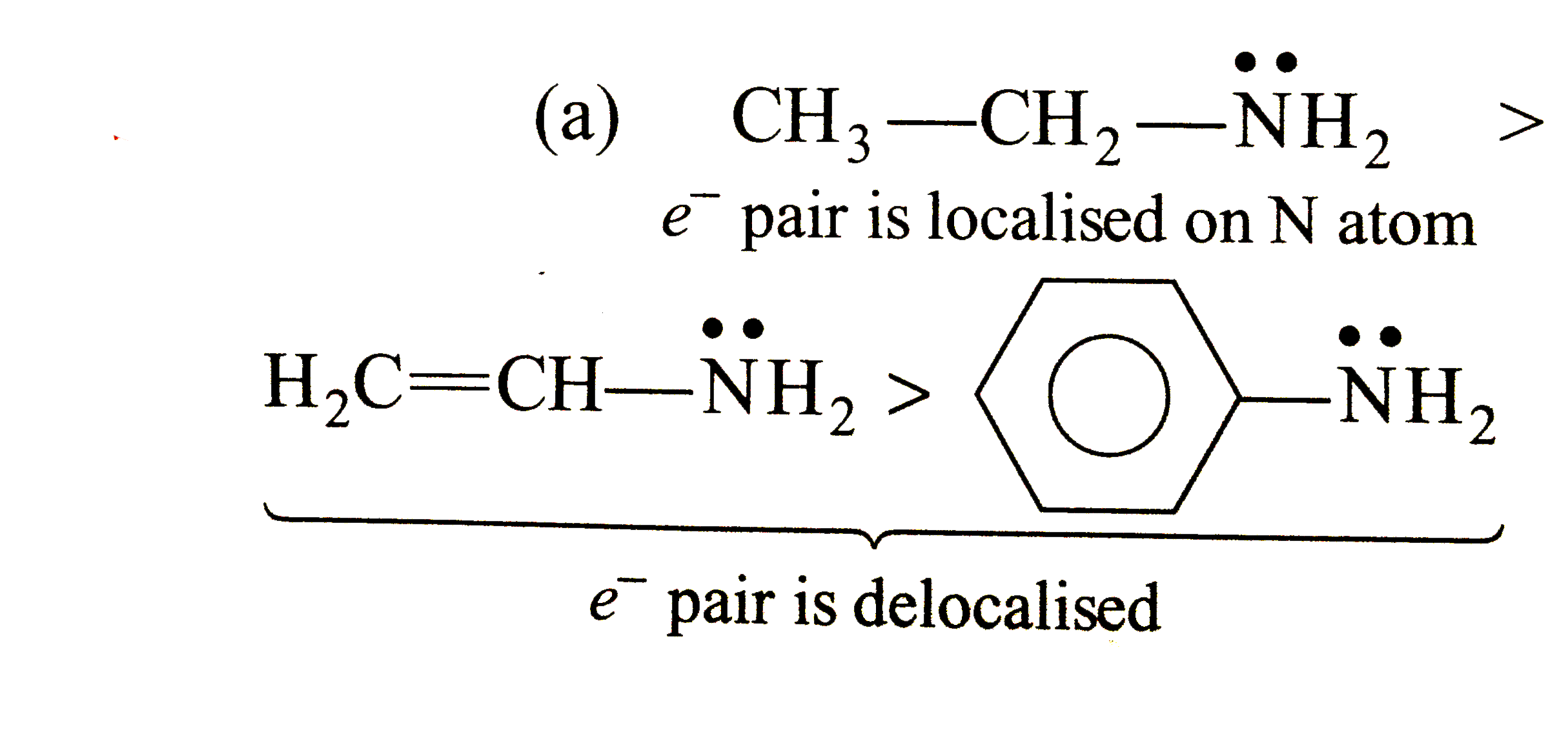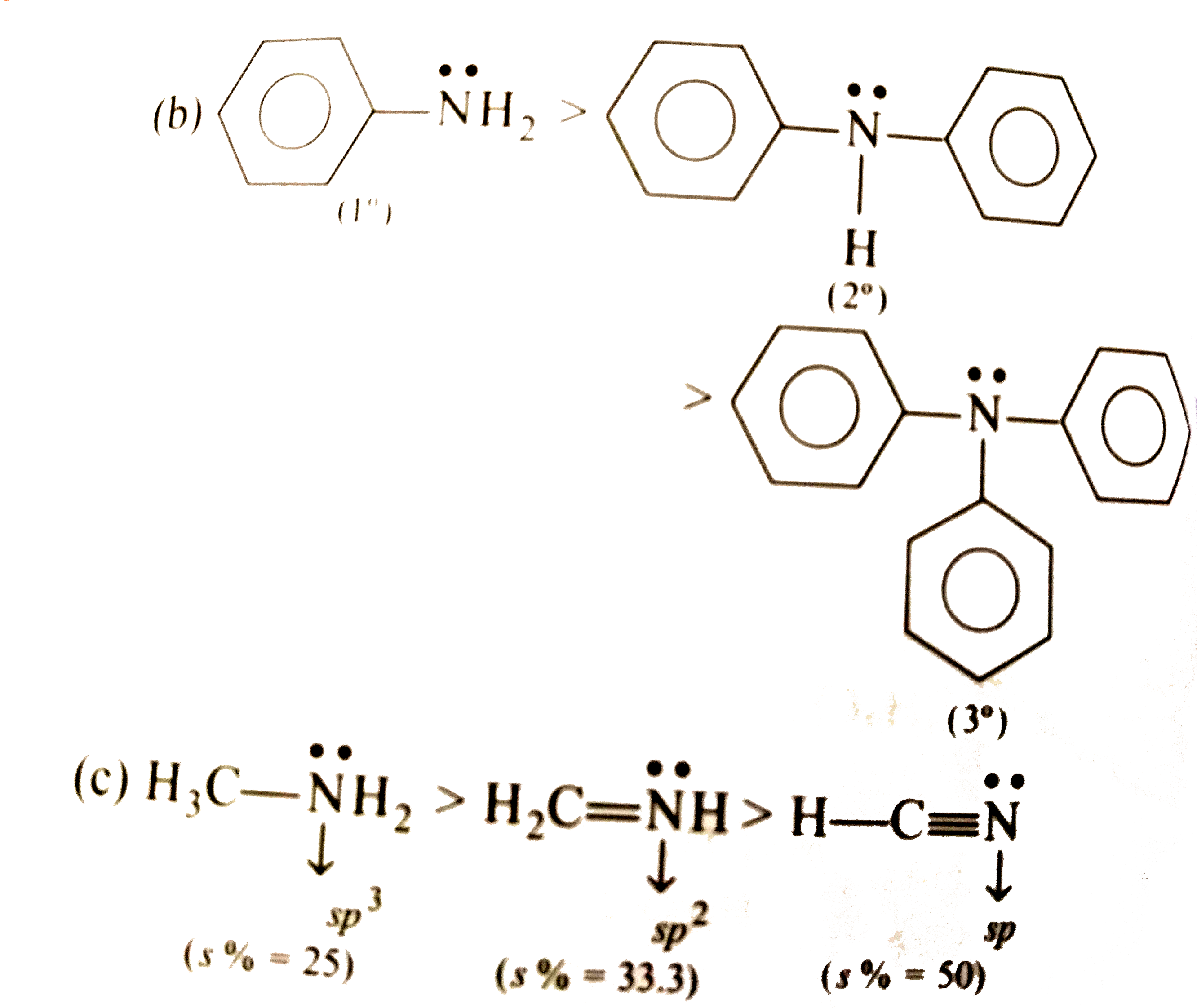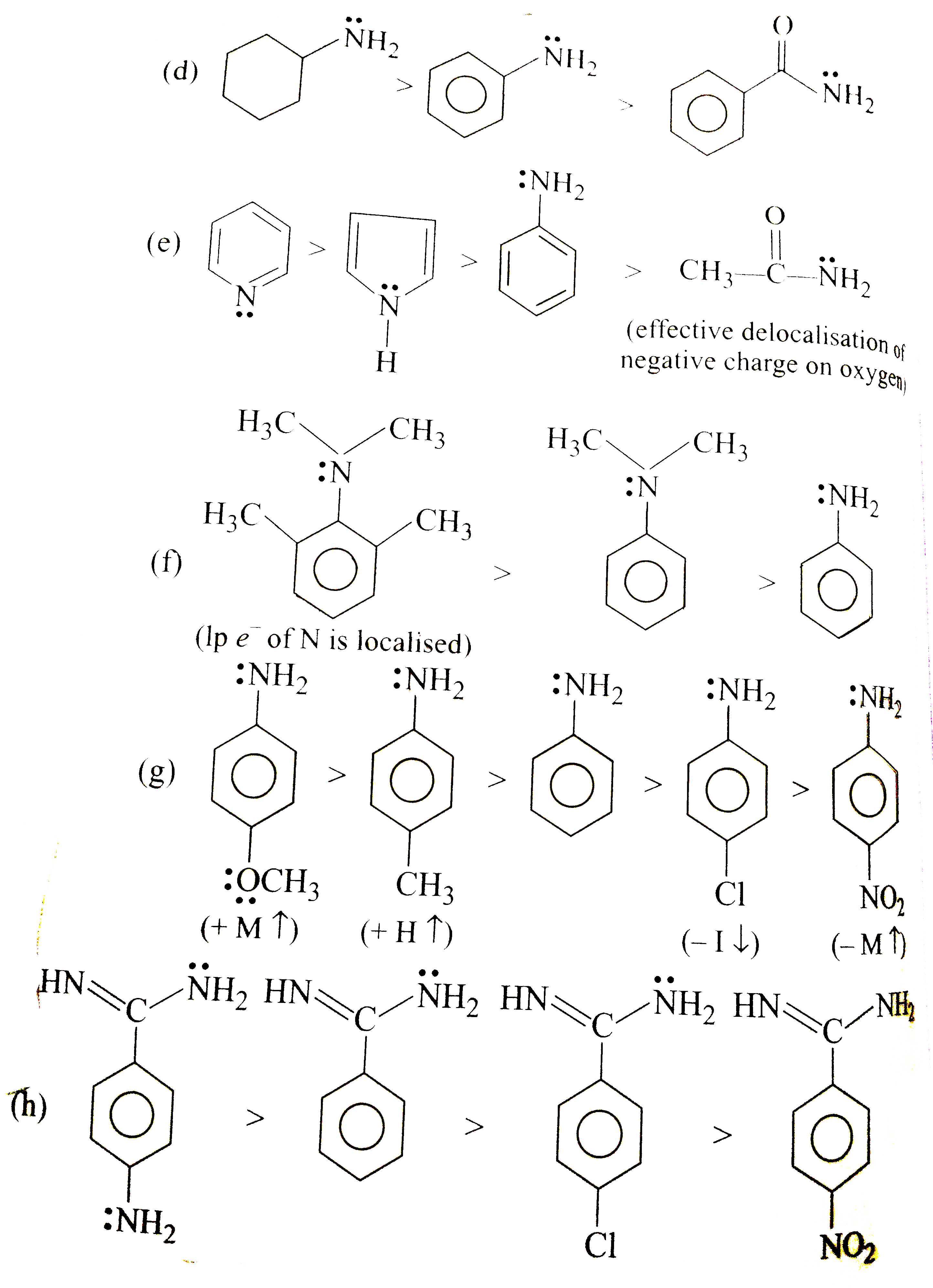Explore topic-wise InterviewSolutions in .
This section includes InterviewSolutions, each offering curated multiple-choice questions to sharpen your knowledge and support exam preparation. Choose a topic below to get started.
| 31001. |
The decreasing order of bond angles from NH_(3) (106^(@)) to SbH_(3)(101^(@)) down group 15 of the periodic table is due to: |
|
Answer» INCREASING bp - LP repulsion. |
|
| 31002. |
The decreasing order of boiling points of alkyl halides is |
|
Answer» `RF gt RCl gt RBr gt RI` Thisis because with the INCREASE in size and mass of halogen atom, the magnitude of VANDER WAAL's forces increase. |
|
| 31003. |
The decreasing order of boiling points of the following alcohols is |
|
Answer» 3 - methylbutan -2- OL `gt` 2 - methylbutan -2- ol `gt` PENTAN -1- ol |
|
| 31004. |
The decreasing order of boiling points of isomeric pentanes is - |
|
Answer» n-pentane `GT` ISOPENTANE `gt` NEOPENTANE |
|
| 31005. |
The decreasing order of basicity of nitrogen in the following compounds is : (a) CH_(3)-CH_(2)-NH_(2),C_(6)H_(5)-NH_(2),H_(2)C=CH-NH_(2) (b) (C_(6)H_(5))_(3)N,(C_(6)H_(5))_(2)NH,C_(6)H_(5)NH_(2) (c) H_(2)C=NH,HCN,CH_(3)NH_(2) (d) C_(6)H_(5)NH_(2),C_(6)H_(11)NH_(2),C_(6)H_(5)CONH_(2) (e) C_(5)H_(5)N,C_(4)H_(4)NH,C_(6)H_(5)NH_(2),CH_(3)CONH_(2) (f) C_(6)H_(5)N(CH_(3))_(2),C_(6)H_(3)(CH_(3))_(2)N(CH_(3))_(2),C_(6)H_(5)NH_(2) (g) H_(2)N-C_(6)H_(4)-OCH_(3),C_(6)H_(5)NH_(2), H_(2)N-C_(6)H_(4)-NO_(2),H_(2)N-C_(6)H_(4)-CH_(2), H_(2)N-C_(6)H_(4)-Cl (h) {:(C_(6)H_(5)-underset("NH")underset("|| ")"C "-NH_(2)","O_(2)N-C_(6)H_(4)-underset("NH")underset("|| ")"C "-NH_(2)),(Cl-C_(6)H_(4)-underset("NH")underset("|| ")"C "-NH_(2)","H_(2)N-C_(6)H_(4)-underset("NH")underset("|| ")"C "-NH_(2)):} |
Answer» Solution :  HIGHER the PERCENTAGE of s-character, the more tightly lone pair is held, and the weaker the base.  Ganidine is strongly basic Basicity of DIFFERENT nitrogen containing compounds is : [Guanidine gt aliphatic amines gt `NH_(3)` gt aromatic amines gt AMIDES gt cyanide] |
|
| 31006. |
The decreasing order of boiling points of 1^@,2^@,3^@ alcohol is : |
|
Answer» `1^@ GT 2^@ gt 3^@` |
|
| 31007. |
The decreasing order of basic character of K_2O, BaO, CaO and MgO is |
|
Answer» `K_2O GT BaO gt CaO gt MgO` |
|
| 31008. |
The decreasing order of basicity of alcohols are |
|
Answer» `3^@ GT 2^@ gt 1^@` |
|
| 31009. |
The decreasing order of aromaticity fo the following is I. Benzene, II. Napthalene, III. Anthrance |
|
Answer» `(I) gt (II) gt (III)` `E.E.//` ring of napthalene (two rings) `= 255//2` `= 127.5 kJ mol^(-1)` `R.E.//"ring"` of anthrance (THREE rings) `= 351//3` `= 117 kJ mol^(-1)` On the basic of `R.E.//"ring", R.E`. of `"benzene"gt"of napathalene" gt "of anthrance". |
|
| 31010. |
The decreasing order of acidity among th following compounds, ethanol (I), 2,2,2-trifluoroethanol (II), trifluoroacetic acid (III) and acetic acid (IV) is |
|
Answer» IIIgtIIgtIVgtI |
|
| 31011. |
The decreasing order of acidity of the following acids is : (1) Ethanoic acid(2) Chloroethanoic acid(3) Trichloroethanoic acid(4) Trifluoroethanoic acid |
|
Answer» `4gt3gt2gt1` |
|
| 31012. |
The decreasing order of acidic character among ethane (I), ethene (II),ethyne (III) and propyne (IV) is |
|
Answer» (I) gt (II) gt (III) gt (IV) Hydrocarbon ATOMS attached to sp-hybridised carbon atom are most ACIDIC , FOLLOWED by those attached to `sp^2`-hybridised carbon -atom, and those attached to `sp^3`-hybridised carbon are least acidic. |
|
| 31013. |
The decreasing nucleophilic order of the following compounds is: i. PhSO_(3)^(o-), ii. C_(2)H_(5)SO_(3)^(o-), iii. C_(2)H_(5)COO^(o-), iv. overset(o-)(C)N, v. overset(o-)(O)H |
|
Answer» `(v) gt (iv) gt (III) gt (ii) gt (i)` |
|
| 31014. |
The decreasing nucleophillic order fo the following compounds is: i. F^(o-), ii. Cl^(o-), iii. Br^(o-), Iv. I^(o-) |
|
Answer» `(i) gt (II) gt (iii) gt (IV)`<BR>`(iv) gt (iii) gt (ii) gt (i)` `I^(o-) gt Br^(o-) gt Cl^(o-) gt F^(o-)` |
|
| 31015. |
The decreasing nucleophilic order of the followingcompounds is: i. NH_(3), ii. PH_(3), iii. AsH_(3), iv. SbH_(3) |
|
Answer» `(i) gt (ii) gt (iii) gt (iv)` |
|
| 31016. |
The decreasing nucelophilic order of the following compoundsis: i. overset(o-)(C)H_(3), ii. Overset(o-)(O)H, iii.CH_(3)COO^(o-), iv. H_(2)O |
|
Answer» `(i) GT (ii) gt (iii) gt (iv)` `overset(o-)(C)H_(3) gt overset(o-)(O)H gt CH_(3)COO^(o-) gt H_(2)O` |
|
| 31017. |
The decreasing nucleophilic oder of the following compounds is: i. overset(o-)(C)H_(3), ii. overset(o-)(N)H_(2), iii. overset(o-)(O)H, iv. F^(o-) |
|
Answer» `(i) gt (ii) gt (iii) gt (iv)` `C overset(o-)(H_(3) gt overset(o-)(N) H_(2) gt overset(o-)(O) H lt F^(o-)` |
|
| 31018. |
The decreasingnucelophilic order of the following compounds is: i. NH_(3), ii. PH_(3), iii. AsH_(3), iv. SbH_(3) |
|
Answer» `(i) gt (ii) gt (III) gt (iv)` `SbH_(3) gt AsH_(3) gt PH_(3) gt NH_(3)` |
|
| 31019. |
The decreasing nucelophilc order of the following compounds is: i. overset(o-)(C)N, ii. overset(o-)(O)H, iii. overset(o-)(O) Me, iv. overset(o-)(C)H_(3), v. H^(o-) |
|
Answer» `(v) gt (iv) gt (III) gt (ii) gt (i)` Basic and nucleophicl orders are same. |
|
| 31020. |
The decreasing leaving group order of the following is: i. F^(o-), ii. Cl^(o-), iii. Br^(o-), Iv. I^(o-) |
|
Answer» `(i) GT (II) gt (iii) gt (IV)` `I^(o-) gt Br^(o-) gt Cl^(o-) gt F^(o-)` |
|
| 31021. |
The decreasing leaving group order of the following is: i. F_(3)CSO_(3)^(o-), ii. Cl_(3)C-COO^(o-) iii. PhSO_(3)^(o-), iv. MeSO_(3)^(o-) |
|
Answer» `(i) GT (ii) gt (III) gt (IV)` Fugavity: `(i) gt (iii) gt (Iv) gt (ii)` |
|
| 31022. |
The decreasing leaving group order (fugacity order) of the following compounds is: i. H_(2)O, ii. H_(2)S, iii. H_(2)Se, iv. H_(2)Te |
|
Answer» `(i) GT (ii) gt (III) gt (IV)` Fugacity: `H_(2) TE gt H_(2) Se gt H_(2) S gt H_(2)O` |
|
| 31023. |
The decreasing basic order of the following is: i. PhSO_(3)^(o-), ii. C_(2)H_(5)SO_(3)^(o-), iii. C_(2)H_(5)COO^(o-), iv. overset(o-)(C)N, v. overset(o-)(O)H |
|
Answer» `(v) gt (iv) gt (iii) gt (ii) gt (i)` BASIC: `PhSO_(3)^(o-) lt C_(2)H_(5)SO_(3)^(o-) lt C_(2)H_(5)COO^(o-) lt overset(o-)(C)N lt overset(o-(O)H` |
|
| 31024. |
The decreasing fugacity order of the following compounds is: i. PhSO_(3)^(o-), ii. C_(2)H_(5)SO_(3)^(o-), iii. C_(2)H_(5)COO^(o-), iv. overset(o-)(C)N, v. overset(o-)(O)H |
|
Answer» `(V) GT (iv) gt (iii) gt (II) gt (i)` `(i) gt (ii) gt (iii) gt (iv) gt (v)` |
|
| 31025. |
The decreasing fugacity order of the following is: i. overset(o-)(C)N, ii. overset(o-)(O)H, iii. overset(o-)(O) Me, iv. overset(o-)(C)H_(3), v. H^(o-) |
|
Answer» `(v) gt (IV) gt (iii) gt (ii) gt (i)` |
|
| 31026. |
The decreasing basic order of the following is: i. overset(o-)(C)H_(3), ii. Overset(o-)(O)H, iii.CH_(3)COO^(o-), iv. H_(2)O |
|
Answer» `(i) gt (ii) gt (iii) gt (iv)` BASIC: `H_(2)O LT CH_(3)COO^(o-) lt overset(o-)(O)H lt overset(o-)(C) H_(3)` |
|
| 31027. |
The decreasingbasic order of the following is: i. overset(o-)(C)H_(3), ii. overset(o-)(N)H_(2), iii. overset(o-)(O)H, iv. F^(o-) |
|
Answer» `(i) gt (ii) gt (III) gt (iv)` Acidic: `HF gt dot(H)_(2) O gt NH_(3) gt CH_(4)` Basic: `F^(o-) lt overset(o-)(O)H lt overset(o-)(N)H_(2) MLT C overset(o-)(H_(3)` |
|
| 31028. |
The decreasing basic order of the following is: i. F^(o-), ii. Cl^(o-), iii. Br^(o-), Iv. I^(o-) |
|
Answer» `(i) gt (II) gt (iii) gt (iv)` Acidic: `Hl gt HBr gt HCl gt HF` Basic: `I^(o-) LT Br lt Cl^(o-() lt F^(o_)` |
|
| 31029. |
The decreasing basic order of the followingcompounds is: i. NH_(3), ii. PH_(3), iii. AsH_(3), iv. SbH_(3) |
|
Answer» `(i) gt (ii) gt (iii) gt (iv)` NH_(3) gt PH_(3) gt AsN_(3) gt Sbh_(3)`. |
|
| 31030. |
The decreasing basic order of the following compounds is: i. H_(2)O, ii. H_(2)S, iii. H_(2)Se, iv. H_(2)Te |
|
Answer» `(i) GT (ii) gt (iii) gt (iv)` Basic: `H_(2)O gt H_(2)S gt H_(2)Se gt H_(2)TE` |
|
| 31031. |
The decrease in the ionisation of H_2S in the presence of HCl is due to : |
|
Answer» SOLUBILITY product |
|
| 31032. |
The decrease in the size of innce transition element is q |
|
Answer» more |
|
| 31033. |
The decrease in electrical conductivity of metals with increase in temperature is due to increase in |
|
Answer» the velocity of ELECTRONS |
|
| 31034. |
The decrasing basic order of the following is: i. Me_(2)N - Nme_(2), ii. MeNH-NHMe iii. H_(2)N - NH_(2), iv. NH_(3) |
|
Answer» `(i) gt (ii) gt (III) gt (IV)` |
|
| 31035. |
The decreaing basic order of the following is: i. overset(o-)(C)N, ii. overset(o-)(O)H, iii. overset(o-)(O) Me, iv. overset(o-)(C)H_(3), v. H^(o-) |
|
Answer» `(v) gt (iv) gt (iii) gt (ii) gt (i)` Basic: `C overset(o-)(N) lt MEO^(o-) lt OH^(o-) lt H^(o-) lt C^(o-)H_(3)` |
|
| 31036. |
The decrasing fugacity order of the following compoundsis: i. overset(o-)(C)H_(3), ii. Overset(o-)(O)H, iii.CH_(3)COO^(o-), iv. H_(2)O |
|
Answer» `(i) gt (II) gt (iii) gt (iv)` `H_(2)O gt CH_(3)COO^(o-) gt OVERSET(o-)(C) H_(3)` |
|
| 31037. |
The decompostion of N_(2)O_(5 (g)) to NO_(3(g)) Proceeds as a first order reaction with a half-life period of 30 seconds at a certain temperature . If the initial concentration [N_(2)O_(5)]= 0.4 M , what is the rate constant of the reaction |
|
Answer» `0.00924 sec^(-1)` |
|
| 31038. |
The decompostion of potassium chlorate speed up in the presence of …………… . |
|
Answer» `MnO_(2)` |
|
| 31039. |
The decompostion of N_(2)O into N_(2) and O_(2) in presence of Argon follows first order kinetics k=5.0xx10^(11)e^(-2000//T(K)). The activation energy is |
|
Answer» `16.628kJ"mol"^(-1)` `epsilon_(a)=2000xxR=20000xx8.3.4=16.628,epsilon_(a)=16.628`KJ/mole |
|
| 31040. |
The decomposittion reaction of ammonia gas on platinum surface has a rate constant =2.5xx10^(-4)" mol L"^(-1)s^(-1). What is the order of the reaction ? |
| Answer» SOLUTION :ZERO ORDER (on the BASIS of units of K) | |
| 31041. |
The decomposition reaction of ammonia gas on platinum surface has a rate constant R = 2.5xx10^(-4)"mol L"^(-1). What is the order of the reaction. |
| Answer» SOLUTION :The ORDER of the REACTION is ZERO. | |
| 31042. |
The decomposition ofdimethyl ether leads to the formation of CH_4, H_2 and CO and the reaction rate isgiven by Rate = k[CH_2OCH_2]^(3//2). The rate of reaction is followed by increase in pressure in a closed vessel and the rate can also be expressed in term s of the partial pressure of dimethyl ether i.e., Rate = k[P_(CH_3OCH_3)]^(3//2). If the pressure is measured in bar and time in minutes, then what are the units of rate and rate constants? |
| Answer» SOLUTION :BAR^(-1//2) "MIN"^(-1)` | |
| 31043. |
The decomposition reactiom of SO_(2)Cl_(2) is the first order reaction.It.s concentration gets halved in 60 minutes what is its rate constant value? |
|
Answer» 0.01155 `MIN^(-1)` |
|
| 31044. |
The decomposition of phosphine, PH_(3), proceeds according to the following equation: 4PH_(3)(g) to P_(4)(g) +6H_(2)(g) It is found that the reaction follows the following rate equation: Rate =k[PH_(3)]. The half-life of PH_(3) is 37.9s at 120^(@)C. (i) How much time is required for 3//4th of PH_(3) to decompose? (ii) What fraction of the original sample of PH_(3) remains behind after 1 minute? |
|
Answer» Solution :`4PH_(3)(g) to P_(4)(g) +6H_(2)(g)` Half-life of `PH_(3)=37.9s` Rate `=k[PH_(3)]` This MEANS that the reaction is of first order. For a first order reaction `k=(0.693)/(t_(1//2)) or k=(0.693)/(37.9)=0.01828496` (i) Apply the relation `k=(2.303)/(t) "log"([R]_(0))/(R )` Here `R=R_(0)-(3)/(4)R_(0)=(R_(0))/(4)` Substituting the values in the equation above, we have `0.01828496=(2.303)/(t)"log"([R]_(0))/([R_(0)]//4)` or `t=(2.303)/(0.01828496)log 4 or t=(2.303)/(0.01828496)xx 0.60206=75.83s` (ii) After 1 minute or 60 seconds `k=(2.303)/(t)"log"([R]_(0))/(R ) or " log"([R]_(0))/(R )=(kt)/(2.303)` Substituting the values, we have `"log"([R]_(0))/(R )=(0.0183xx60)/(2.303)=0.4768` Taking antilogarithm, we have `([R]_(0))/(R )=2.992 or (R )/([R]_(0))=(1)/(2.992)=0.3342` |
|
| 31045. |
The decomposition of phosphine (pH_(3))on tungsten at low pressure is a first-order reaction .It is because the …….. |
|
Answer» rate is independent of the surface COVERAGE. |
|
| 31046. |
The decomposition of phosphine (PH_(3)) on tungsten at low pressure is a first-orfer reaction . It is because the |
|
Answer» RATE of decomposition is very slow It is independent of the the surface coverage because ZERO ORDER REACTION depend on surface area covered by reactant . |
|
| 31047. |
The decomposition of phosphine (PH_(3)) on tungsten at low pressure is a first - order reaction. It is because the |
|
Answer» Rate is PROPORTIONAL to the SURFACE coverage |
|
| 31048. |
The decomposition of phosphine (PH_3) on tungsten at low pressure is a first order reaction . It is because the ..................[NEET] |
|
Answer» rate is proportional to the surface converge Rate `prop` (surface AREA) At HIGH pressure due to the complete coverage of surface area. The reaction follows ZERO order. Rate `prop ["reaction"]^0` Therefore the rate is independent of surface area. . |
|
| 31049. |
The decomposition of phosphine (PH_(3)) on tungsten at low pressure is a first-order reaction. It is because the- |
|
Answer» rate of DECOMPOSITION is very low |
|
| 31050. |
The decomposition of ozone proceeds as : O_(3) rarr O_(2) + O (fast) O+ O_(3) rarr 2O_(2) (slow ) The rate expression should be : |
|
Answer» Rate = `k[O_(3)]^(2) ` or `[O] = k ([O_(3)])/([O_(2)])` `:. "Rate" = (k[O_(3)][O_(3)])/([O_(2)])=[O_(3)]^(2)[O_(2)]^(-1)` |
|